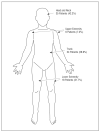Long-term follow-up and survival of patients following a recurrence of melanoma after a negative sentinel lymph node biopsy result
- PMID: 23325294
- PMCID: PMC3856253
- DOI: 10.1001/jamasurg.2013.1335
Long-term follow-up and survival of patients following a recurrence of melanoma after a negative sentinel lymph node biopsy result
Abstract
Objective: To analyze the predictors and patterns of recurrence of melanoma in patients with a negative sentinel lymph node biopsy result.
Design: Retrospective chart review of a prospectively created database of patients with cutaneous melanoma. SETTING Tertiary university hospital.
Patients: A total of 515 patients with melanoma underwent a sentinel lymph node biopsy without evidence of metastatic disease between 1996 and 2008.
Main outcome measures: Time to recurrence and overall survival.
Results: Of 515 patients, 83 (16%) had a recurrence of melanoma at a median of 23 months during a median follow-up of 61 months (range, 1-154 months). Of these 83 patients, 21 had melanoma that metastasized in the studied nodal basin for an in-basin false-negative rate of 4.0%. Patients with recurrence had deeper primary lesions (mean thickness, 2.7 vs 1.8 mm; P < .01) that were more likely to be ulcerated (32.5% vs 13.5%; P < .001) than those without recurrence. The primary melanoma of patients with recurrence was more likely to be located in the head and neck region compared with all other locations combined (31.8% vs 11.7%; P < .001). Median survival following a recurrence was 21 months (range, 1-106 months). Favorable characteristics associated with lower risk of recurrence included younger age at diagnosis (mean, 49 vs 57 years) and female sex (9% vs 21% for males; P < .001).
Conclusion: Overall, recurrence of melanoma (16%) after a negative sentinel lymph node biopsy result was similar to that in previously reported studies with an in-basin false-negative rate of 4.0%. Lesions of the head and neck, the presence of ulceration, increasing Breslow thickness, older age, and male sex are associated with increased risk of recurrence, despite a negative sentinel lymph node biopsy result.
Figures



Comment in
-
Early diagnosis of metastatic disease in melanoma: does it make a difference?: Comment on "Long-term follow-up and survival of patients following a recurrence of melanoma after a negative sentinel lymph node biopsy result".JAMA Surg. 2013 May;148(5):462. doi: 10.1001/jamasurg.2013.1345. JAMA Surg. 2013. PMID: 23325337 No abstract available.
Similar articles
-
Sentinel lymph node biopsy in thick malignant melanoma: a 10-year single unit experience.J Plast Reconstr Aesthet Surg. 2012 Oct;65(10):1396-402. doi: 10.1016/j.bjps.2012.04.019. Epub 2012 May 1. J Plast Reconstr Aesthet Surg. 2012. PMID: 22552263
-
Patterns of initial recurrence and prognosis after sentinel lymph node biopsy and selective lymphadenectomy for melanoma.Plast Reconstr Surg. 2003 Aug;112(2):486-97. doi: 10.1097/01.PRS.0000070989.23469.1F. Plast Reconstr Surg. 2003. PMID: 12900606
-
Recurrence of cutaneous melanoma of the head and neck after negative sentinel lymph node biopsy.Head Neck. 2015 Aug;37(8):1116-21. doi: 10.1002/hed.23718. Epub 2014 Jul 11. Head Neck. 2015. PMID: 24764188
-
Melanoma arising in association with blue nevus: a clinical and pathologic study of 24 cases and comprehensive review of the literature.Mod Pathol. 2014 Nov;27(11):1468-78. doi: 10.1038/modpathol.2014.62. Epub 2014 Apr 18. Mod Pathol. 2014. PMID: 24743221 Review.
-
Management of Malignant Vulval Melanoma: A Retrospective Case Series and Review of the Literature.J Low Genit Tract Dis. 2020 Jul;24(3):272-276. doi: 10.1097/LGT.0000000000000521. J Low Genit Tract Dis. 2020. PMID: 32205765 Review.
Cited by
-
Head & neck melanoma: A 22-year experience of recurrence following sentinel lymph node biopsy.Laryngoscope Investig Otolaryngol. 2021 Jun 21;6(4):738-746. doi: 10.1002/lio2.605. eCollection 2021 Aug. Laryngoscope Investig Otolaryngol. 2021. PMID: 34401498 Free PMC article.
-
Recurrence Rates Over 20 Years in the Treatment of Malignant Melanoma: Immediate Versus Delayed Reconstruction.Plast Reconstr Surg Glob Open. 2017 Jul 12;5(7):e1378. doi: 10.1097/GOX.0000000000001378. eCollection 2017 Jul. Plast Reconstr Surg Glob Open. 2017. PMID: 28831336 Free PMC article.
-
The RPL/RPS gene signature of melanoma CTCs associates with brain metastasis.Cancer Res Commun. 2022 Nov;2(11):1436-1448. doi: 10.1158/2767-9764.crc-22-0337. Epub 2022 Nov 16. Cancer Res Commun. 2022. PMID: 36407834 Free PMC article.
-
Localization of sentinel lymph nodes using augmented-reality system: a cadaveric feasibility study.Eur J Nucl Med Mol Imaging. 2025 Aug;52(10):3643-3652. doi: 10.1007/s00259-025-07216-z. Epub 2025 Mar 24. Eur J Nucl Med Mol Imaging. 2025. PMID: 40123008
-
Sentinel Lymph Node Biopsy and Complete Lymph Node Dissection for Melanoma.Curr Oncol Rep. 2019 Apr 26;21(6):54. doi: 10.1007/s11912-019-0798-y. Curr Oncol Rep. 2019. PMID: 31028497 Free PMC article. Review.
References
-
- Cancer facts and figures 2005. American Cancer Society; [Accessed April 27, 2012]. website. http://www.cancer.org/research/cancerfactsfigures/cancerfactsfigures/can....
-
- Siegel R, Naishadham D, Jemal A. Cancer statistics, 2012. CA Cancer J Clin. 2012;62(1):10–29. - PubMed
-
- Kretschmer L, Starz H, Thoms KM, et al. Age as a key factor influencing metastasizing patterns and disease-specific survival after sentinel lymph node biopsy for cutaneous melanoma. Int J Cancer. 2011;129(6):1435–1442. - PubMed
-
- Balch CM, Soong SJ, Murad TM, Ingalls AL, Maddox WA. A multifactorial analysis of melanoma: II, prognostic factors in patients with stage I (localized) melanoma. Surgery. 1979;86(2):343–351. - PubMed
MeSH terms
Grants and funding
LinkOut - more resources
Full Text Sources
Other Literature Sources
Medical

